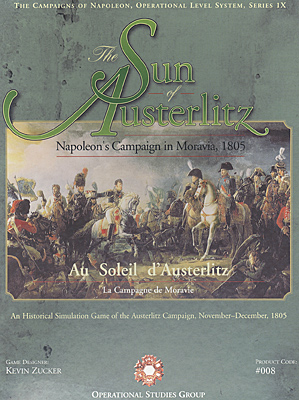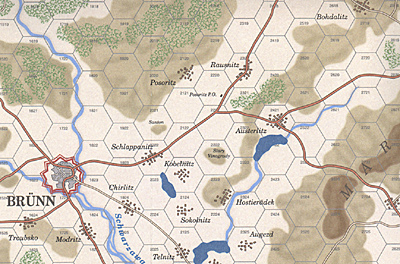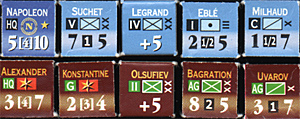Back of Box Blurb
Here's the back of the box info about what the wargame attempts to do, followed by the actual review.
 OPERATIONAL STUDIES GROUP
OPERATIONAL STUDIES GROUP
PO. Box 50207 Baltimore, MD 21211 USA
The Sun of Austerlitz
Napoleon's Campaign in Moravia, 1805
An Historical Simulation Game of the Austerlitz Campaign, November-December, 1805
$46
www.napoleongames.com
kzucker@charm.net
THE TIME IS: 1400 HOURS, 30 NOVEMBER 1805
Napoleon arrived from headquarters to meet with his key Marshals on the Pratzen Plateau. The Pratzen commanded a wide view of the whole region, and he was determined to fight here. Standing on the summit near a feature called the "Stari Vinohrady" and gazing eastward, Napoleon and his Marshals beheld an amazing sight: the entire enemy army, some 72,000 strong, emerging from the village of Austerlitz and marching straight toward the heights on which they stood.
Napoleon had intelligence of the enemy plan to attack his center or his right, and cut-off his communications with the great depot of Vienna. The Emperor had no intention of interfering with this plan. "If they dare to descend from the heights to take me in my flank, they will surely be beaten without hope of recovery."
Pulling back his cavalry, Napoleon allowed the enemy to occupy the entire heights. This was, after all, just what the Austrian Chief of Staff had predicted. Everything seemed to be going according to plan.
Napoleon's deliberately-weakened right flank was a tempting target for the southern columns under General Buxhowden. From the onset of their attack, commencing at 7 A.M. on 2 December, the outmanned French defenders were on the ropes. However, a road-weary division under Marshal Davout arrived from Vienna in time to check the enemy in a terrible struggle at Sokolnitz.
Just before 8 A.M., the fog lifted from the battlefield, exposing the enemy flank march well underway. Napoleon was standing upon the Zuran Hill, looking at the light of dawn. "Yonder shines the Sun of Austerlitz -- a sign that today shall be a day of Victory."
As the Russians poured off the heights to reinforce the south, Napoleon unleashed Soult's IV Corps into their vacated center. The enemy column under Marshal Kolowrat attempted to plug the gap, and the battle entered its critical phase. But determined Russian and Austrian counterattacks failed to drive Soult from the heights.
The Coalition left wing was driven back upon the lakes and decimated, but the Russian right under the firey Prince Bagration held, allowing the Tsar's battered Guard to withdraw to safety. Napoleon's cavalry commander, Marshal Murat, launched a vigorous pursuit picking up many stragglers. The Russians lost about 20,000 men and the Austrians 5,900, along with 180 guns; the French lost 8,000 men.
GAME DESIGN: Kevin Zucker
GAME SYSTEM: Napoleon at Bay/Operational Series 1X
PLAYERS: Two (or two teams)
SCENARIOS:
The Maneuver of Hollabrunn
The Austro-Russian Advance
The Battle of Austerlitz
Two Campaign Games starting on 15 November or 27 November
COMPONENTS:
One 22 x 34" full color map and 280 two-sided units.
48 pages of rules including campaign analysis, designer notes and more.
7 player aids cards, including organization displays, unit and leader manifests, and turn record track.
 Review
Review
If you want a real appreciation for operational warfare in the 1805 Austerlitz campaign, Sun of Austerlitz will certainly teach you a thing or two about time, distance, and cohesion. With easy-to-learn basic rules and added complexity and realism through optional rules, Sun of Austerlitz delivers a lesson you won't find in any tactical wargame.
Map section shows the battlefield of Austerlitz, center right of image. Hexes are 5/8" wide.
Game scale is 3.2km (2 miles) per hex, a strength point is 1000 men, and a game turn is 2 days. The main counters that move upon the map are leaders, while division- and brigade-sized counters appear on an Organizational Display. Cavalry vedettes are also upon the map, more for fog of war than combat operations.
Components
I have extolled the virtues of OSG maps before, notably 1806 and Highway to the Kremlin, and Sun of Austerlitz is no exception. This magnificent map from Joe Youst and Mark Simonitch merges the practical with the artistic. Once you place the counters and start the simulation, you'll appreciate the terrain even more. For 1000 words of description, see the photo above.
 A handy leader and unit manifest allow you to set up the counters prior to a scenario. The organization display tracks the units' strengths. Think of it like a roster system without the paper and pencil. It is supposed to be kept secret from the opponent--a box lid will suffice in a pinch--in order to promote fog of war.
A handy leader and unit manifest allow you to set up the counters prior to a scenario. The organization display tracks the units' strengths. Think of it like a roster system without the paper and pencil. It is supposed to be kept secret from the opponent--a box lid will suffice in a pinch--in order to promote fog of war.
The top of the Austro-Russian manifest, leaders on the left and units on the right. Note that the three columns of boxes correspond to the three scenarios. Leaders have a hex number (and sometimes a town) for initial placement, while units have a strength point amount.
This is a bit different from a typical wargame, where units are on the map directly. Although you can split off an individual division (a handy un-named "major general" counter will be placed on the map), the command and control rules will soon make you painfully aware of the difficulties of spreading out your forces too much.
Leadership
I find this a strong point of the system. The game offers a chain of command with only so many forces available to any one leader. In other words, you can only stuff so many divisions under a particular leader, and only so many leaders under another leader higher up in the chain of command. It's a pretty clever mechanism.
In addition, there's an army competence level that allows only so many "automatic" movements in a turn. After that, it's a die roll based on the competency of the particular leader. Your good leaders move most of the time at or near maximum movement capabilities. The less effective leaders, well, I wouldn't want to depend on them during some sort of critical maneuver--use the automatic movement for these.
Supply
Supply offers the next lesson in operational decision-making. You can only go so far from a supply depot, it takes time to switch depots, and you really don't want to shift your line of communication in the middle of the campaign. You can do so, as Napoleon did at times, but consequences abound. This is a great little section of rules writing and concept here.
Attrition
If one aspect of the game really made my jaw drop, march attrition was it. The losses can be staggering. Basically, much depends upon the general army state, reflected in "Adminstration Points." The more of these you possess, the easier it is to move and the less you suffer attrition. These APs cover a multitude of factors, but basically, the more the better.
The first scenario shows the French almost to the end of their resources. They have 3 AP. The Russians/Austrians have 10. Here's an example of march attrition.
Murat, Lannes, Soult, and 34,000 troops march up the main road. The weather's lousy: mud. They march 10 miles (the maximum), all on the road. The player rolls a die (low rolls are better than high rolls), and sure enough, up comes a 6 (the worst possible result). Mud is bad, so +1 gets added to the die roll. However, Murat is such an inspirational leader, he gives -1 to the die roll. So, 6+1-1=6. Looking at the "March Attrition Table," cross indexing all of the above, provides the loss: 7. That means that 7,000 men fell out on an uncontested march (about 20% of the entire force).
Wow. A couple more marches like that and there will be little left of the army. Had the die roll been 1 (+1 mud, -1 Murat), the loss would be 4 (4,000 men). Even if Lannes, Soult, and Murat were to move separately, they'd suffer a loss of 1 or 2 each.
The next turn, with only 27,000 men and a die roll of 2 (+1 mud, -1 Murat), the force lost 3,000 more men. So, after 20 miles in 4 days, the 34,000 troops were down to 24,000. Ouch.
If you want to force march, well, you get the idea that you can move faster but lose more men.
The campaign game adds a considerable amount of decision-making through additional rules for supply, lines of communications, bridges, and so on. Realism and complexity often go hand-in-hand.
Combat
In the basic game, you have two choices: Pitched (stand and fight), or Pursuit (pack up and run). Advanced rules add Rearguard (cover the retreat). There's a sequence to the combat, including strength estimates, artillery bombardment, and then tallying up combat factors to get odds. A die roll determines losses. Depending on what the defender's choice was, the defenders either cut and run (Pursuit) or take more losses and counterattack (Pitched). The mechanics are relatively simple.
If you manage to win a "critical battle" in which 7,000+ enemy troops fall, you gain the equivalent of a victory point.
There's also an attempt at overrun, which is gambling a bit because the actual number of troops is not known until the attacker attempts to "Repulse" the defenders. You need 7:1+ odds to succeed. In one game, Murat tried this, but only mustered 5:1, and so was stopped and given a penalty during the combat phase.
The French can also "stake the Guard," that is to say, use the Imperial Guard in the attack, which is great if you win, but can cause casualties among the precious Imperial Guard (who don't suffer march attrition, by the way). It also affects victory points if the Guard recoils, so to speak.
There is some pursuit, which depends on the amount of cavalry and the leader involved. Tables and die rolls will adjust the length of pursuit.
Victory
In all scenarios, the most victory points wins, but...victory points (technically, adjustments to "Vienna Morale") are earned from winning critical battles, so you have to be aggressive to win. The Austro-Russians also receive 2 VPs if they have seven infantry strength points or more on the main road between Floridsdorf and Brunn with a secure line of communications.
For campaign game victory, the players still collect VPs for battles, and more for geographic objectives, but otherwise the French player rolls on the "Negotiation Table" every turn, which has a number of results from "no effect" to "negotiations" (a truce), to "rejection" (offering a chance at bringing in a Prussian Army!). The level of victory still depends on VPs at the end of the game, but the level changes depending on whether the Prussians arrive. It sounds more difficult than it really is to calculate the victory.
 Snipe and Tripe
Snipe and Tripe
Alas, no system is perfect, so here's some things to consider.
Sample counters, including leaders, infantry divisions (both sides), artillery, and cavalry. Counters are 1/2" wide.
You have to be careful with the organizational display. During a game, I dropped the lid and jostled the counters. I believe I placed everything back as it was. Worse, the strength point track only goes from 1-5. If a unit has more than 5,000 men, as most do, you flip the counter over: it has a (+5) on the reverse side, which means add 5 strength points to the unit. It is entirely possible that a counter can flip over during an accident.
Regarding movement, while I like the leadership rules a lot, I believe certain rear area movements, such as re-inforcements appearing on map, should be automatic. It doesn't make sense to me that if you have a group, a leader, and an open road to the front, a bad die roll will halt troops in their tracks. I'd go with this idea in 1813-14 when Cossacks ranged far behind the lines, 1809 in the Tyrol, 1812 in Russia, or even in Spain, but in 1805? Once these re-inforcements arrived within a few imles of the front, then they're placed at the disposal of a leader, but when these re-inforcements are 40-50 miles behind the front, they ought to be able to march without a die roll. I inserted a house rule here.
Examples of Play
The system is relatively clean, although I did have a question here and there. Most resolve around the combat process. Fortunately, an example of play resolved all of them. I hasten to add that reading the example of play is critical if you've picked up Sun of Austerlitz for the first time.
A scenario takes about 1/2 hour to 45 minutes per turn on first playing, including poking through the rules, although adding optional rules will lengthen it. The first scenario is 6 turns, the second 8 turns, and the third 6 turns. I did not play the campaign game (16 turns), but with the added complexity of those rules, perhaps offset by greater player familiarity from scenario play, you're looking at 10-12+ hours. The rules suggest 6-8 hours for the campaign, but I suspect that's with two players who are rules experts. Starting the campaign game with the second scenario reduces the time needed.
Conculsion
Ultimately, any wargame becomes a mathematical exercise of matching your thought process to the game mechanics process. The die provides the variable, but your evaluation of various situations and your application of various strategies contain the spark of victory or the stirrings of defeat. Your imagination transforms a simple die roll into a battle, but the designer supplies the charts and tables.
Simply put, Sun of Austerlitz makes you think. It makes you weigh options. It makes you consider the implications of every march, every piece of terrain, and every combat. Counter density is low, and every loss felt so dearly, that decisions have a cascading effect upon your campaign. You face a real challenge making up for bad decisions, especially if your opponent presses the matter.
The 1805 campaign of Austerlitz offers a million different outcomes. Sun of Austerlitz allows you to explore each one.
Back to Historical Game Review List
Back to Master Game Review List
Back to MagWeb Master Magazine List
© Copyright 2004 by Coalition Web, Inc.
This article appears in MagWeb.com (Magazine Web) on the Internet World Wide Web.
Other articles from military history and related magazines are available at http://www.magweb.com
|

